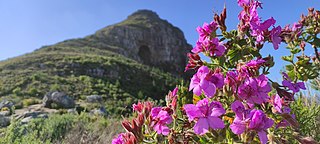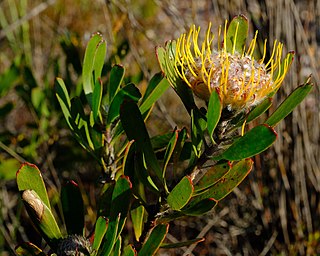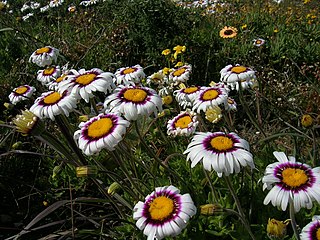
Brunfelsia pauciflora is a species of flowering plant in the family Solanaceae, the nightshades. It is endemic to Brazil, and it is grown in cultivation. A shrubby perennial plant grown in gardens, its common names include today, tomorrow together, yesterday, today and tomorrow, morning-noon-and-night, kiss me quick, and Brazil raintree.

Brunfelsia latifolia, commonly known as yesterday-today-tomorrow and kiss me quick, is a species of flowering plant in the nightshade family. Endemic to Brazil, it is an evergreen shrub that becomes semi-deciduous in cooler areas and grows up to 1.8 meters in height.

Stemodia durantifolia is a species of flowering plant in the plantain family commonly known as the whitewoolly twintip and purple stemodia. Stemodia durantifolia is native to the Americas, including Chile, Mexico, Texas, and the deserts of California and Arizona, and is often found in riparian habitats, preferring wet sand and rocks. It is a perennial herb producing a hairy, glandular, erect stem 10–100 cm (3.9–39.4 in) tall, with the toothed lance-shaped leaves found in pairs or triplets, attached to the stem with clasping bases. The inflorescence is a raceme of violet flowers, with each corolla held in a calyx of hairy, pointed sepals, and can often be found in bloom year-round. Although globally at low risk of extinction, Stemodia durantifolia is imperiled in California due to its rarity and threats from development.

Pelargonium cucullatum is a hairy, upright, branching, perennial shrub, of 1–2 m (3.3–6.6 ft) high, that has been assigned to the cranesbill family. It sprouts new stems from the underground rootstock and becomes woody at its base. It has alternately set, sometimes slightly succulent leaves crowded near the top of the branches, with leaf stalks and flat to hood-shaped leaf blades, with a rounded broad triangular to kidney-shaped outline of about 4–5.5 cm long and 5–9 cm wide, often somewhat incised, the margin with irregular teeth. The white to purplish red, 5-merous, somewhat mirror symmetrical flowers grow in umbel-like clusters, and each contain mostly 7 fertile stamens and 3 infertile staminodes of different length. P. cucullatum has been cultivated as a garden ornamental and house plant since the 17th century. It has been used to breed many modern pelargonium hybrids, notably the Regal pelargoniums. It is called hooded-leaf pelargonium or herba althaea in English and wildemalva in Afrikaans.

Babiana ambigua is a species of plant in the Iridaceae. It is endemic to the Western Cape province of South Africa. It is a geophyte, that appears from an underground corm every year and grows to a height of 5–8 cm (2.0–3.1 in) or occasionally up to 16 cm (6.3 in). Its leaves are pleated, hairy, lance-shaped, reaching higher than the inflorescence. The fragrant, mirror-symmetric, blue to mauve flowers, consist of six tepals merged into a tube at their base, but with free lobes at the top. The lower lateral tepals have whitish markings accentuated by a more intense blue line along their margin. Each flower is supported by two green bracts sometimes with a brownish tip, and the inner bract is divided entirely to its base. There are three anthers crowded to the dorsal side of the perianth and a style divided in three branches on top of a smooth ovary. Flowers can be found from late July at sea level to the end of September at high altitude.

Eremophila granitica, commonly known as granite poverty bush and thin-leaved poverty bush is a flowering plant in the figwort family, Scrophulariaceae and is endemic to Western Australia. It is an erect, open shrub with sticky, narrow leaves and with lilac-coloured flowers.
Verticordia pityrhops, commonly known as East Mount Barren featherflower or pine-like featherflower, is a flowering plant in the myrtle family, Myrtaceae and is endemic to the south-west of Western Australia. It is a single-stemmed shrub which is densely-branched with crowded narrow linear leaves giving the impression of a miniature pine tree. When it flowers in autumn, the shrub is completely covered with masses of very small, honey-scented, pinkish-purple flowers.
Caladenia colorata, commonly known as coloured spider-orchid, small western spider-orchid and painted spider-orchid is a plant in the orchid family Orchidaceae and is endemic to South Australia and possibly Victoria. It is a ground orchid with a single hairy leaf, and usually a single creamy-green flower with blood-red or purple-brown markings and with dark tips on the petals and sepals.
Asperula hercegovina, commonly known as the Hercegovinian woodruff, is a herb endemic to Bosnia & Herzegovina of the Rubiaceae family.
Euphorbia gregersenii, or Gregersen's spurge, is a plant in the family Euphorbiaceae: spurges.

Leucospermum utriculosum is a lax, evergreen, upright and arching shrub of 1–2 m high, from the family Proteaceae. It has hairless inverted lance-shaped to oblong leaves tipped with three to five teeth and globe-shaped to flattened light yellow to coppery flowerheads of 5–8 cm (2.0–3.2 in) in diameter. From the center of the flowers emerge almost straight styles that jointly give the impression of a pincushion. It is called Breede River pincushion in English. Although flower heads may occur on and off between May and March, the peak season is from September to November. It is known from the Western Cape province of South Africa.

Leucospermum saxatile is an evergreen, rising to sprawling shrub of ½–¾ m high and 1–1½ m (3⅓–5 ft) wide, from the family Proteaceae. It has reddish tinged flowering stems and line-shaped, narrowing wedge-shaped leaves of 2½–5 cm(1–2 in) long and 2–5 mm (0.08–0.20 in) wide, with one to three blunt teeth, whorl-shaped, flat-topped, at first pale lime green but later carmine flower heads of 2½–3 cm across, mostly individually but sometimes grouped with two or three, each on a stalk. The flower heads occur from July to October. From the flowers occur long styles with a slightly thicker tip, which together give the impression of a pincushion. It is called Karoo pincushion in English. Flowering heads can be found from July until February. It naturally occurs in fynbos in the Western Cape province of South Africa.

Felicia josephinae is a roughly hairy annual herbaceous plant of 15–20 cm (6–8 in) high, that is assigned to the family Asteraceae. It branches near its base, and has few leaves along its stems. The lower leaves are set oppositely, inverted lance-shaped, relatively large at 3–7 cm long and ⅔–1¼ cm wide, and soon withering, while the higher ones are smaller and relatively narrower. In the axils of the leaves grow flower heads of 7–8 mm wide on stalks of up to 5 cm (2.0 in) long, topped with an involucre of about 5 mm (0.20 in) high and 4 mm (0.16 in) wide, consisting of eleven to thirteen bracts in two rows with bristles near the tip, eight to nine white or cream-coloured ligulate florets surrounding fourteen or fifteen deep purple disc florets. Flowers can be found in September and October. The species is an endemic species that can only be found in a small area along the west coast of the Western Cape province of South Africa.

Felicia heterophylla is a roughly hairy annual plant in the family Asteraceae. It has alternate leaves of 1–5 cm long with an entire margin or few inconspicuous teeth. The flower heads are set individually at the tip of its stems, and contain a whorl of purplish blue ray florets around a center of blackish blue disk florets. Flower heads appear in winter and spring. It is called true-blue daisy in English and bloublomastertjie in Afrikaans. It is an endemic species that only occurs in the Western Cape province of South Africa.

Sarcochilus hillii, commonly known as myrtle bells, is a small epiphytic orchid native to eastern Australia and New Caledonia. It has up to ten drooping, quill-shaped leaves and up to ten frosty white or pink flowers that have a hairy labellum with purple stripes.

Felicia elongata is a perennial plant of up to 40 cm high that is assigned to the family Asteraceae. It has stiff, oval, opposing leaves with one distinctive vein and entire margin. The 5 cm (2 in) wide flower heads are very conspicuous in colour, white with a dark purple zone at the base of the ray florets and an orange-yellow disc. Flowering occurs from late August to September, or if the rains arrive late, sometimes October. It is a rare species that is restricted to the Saldanha Bay area. It is sometimes called Saldanha felicia or tricolour felicia in English, and driekleurblommetjie in Afrikaans.

Felicia bellidioides is a perennial plant of up to about 25 cm (10 in) high, that is assigned to the family Asteraceae. Most of the narrowly inverted egg-shaped leaves are silky hairy and in a basal rosette with no or few very narrow bracts on the stalk in the subspecies bellidioides. In the subspecies foliosa, the narrower leaves are not silky hairy but variously bristly and glandular, with more and larger bracts on the inflorescence stalk. The flowerheads sit individually on top of a long peduncle and consist of an involucre with only two worls of bracts, about twenty purplish blue ray florets, surrounding many yellow disc florets. It occurs in the Western Cape province of South Africa.

Mairia petiolata is a tufted, variably hairy, perennial plant of up to 15 cm (6 in) assigned to the family Asteraceae. Its leaves are in a ground rosette, and have a stalk of mostly 2–5 cm long and an inverted egg-shaped to elliptic, 61⁄2–9 cm (2.6–4.6 in) long and 2–3 cm wide leaf blade, with a toothed margin. It mostly has two flower heads at the tip of the branches of each erect, dark reddish brown scape. The flower heads have a bell- to cup-shaped involucre that consists of 20–24, purplish, overlapping bracts in 3–4 whorls. These protect 12–16 pink, ray florets, surrounding many yellow disc florets. This species was only seen flowering once, in December. It is known from one location in the Langeberg, Western Cape province of South Africa.
Otholobium dreweae is an upright shrublet assigned to the Pea family of about 15 cm (5.9 in) high, that appears after the vegetation burned down from the underground rootstock and forms mat-like clumps of hardly branching, leafy stems. The stems are set with stiff, entire, alternate leaves with a single leaflet and heads consisting of 12-18 initially dark pink, later white, pea-like flowers with a white nectar guide on a peduncle as long as the leaves at the end of the stem. This species is an endemic of the Kleinrivier Mountains in the Western Cape province of South Africa. It mostly flowers in November.
Thomasia × formosa is a species of flowering plant in the family Malvaceae and is endemic to a restricted area of the south-west of Western Australia. It is an erect, compact shrub with densely hairy branchlets, hairy, coarsely serrated, egg-shaped to elliptic or oblong leaves, and racemes of pink or purple flowers arranged in leaf axils.














